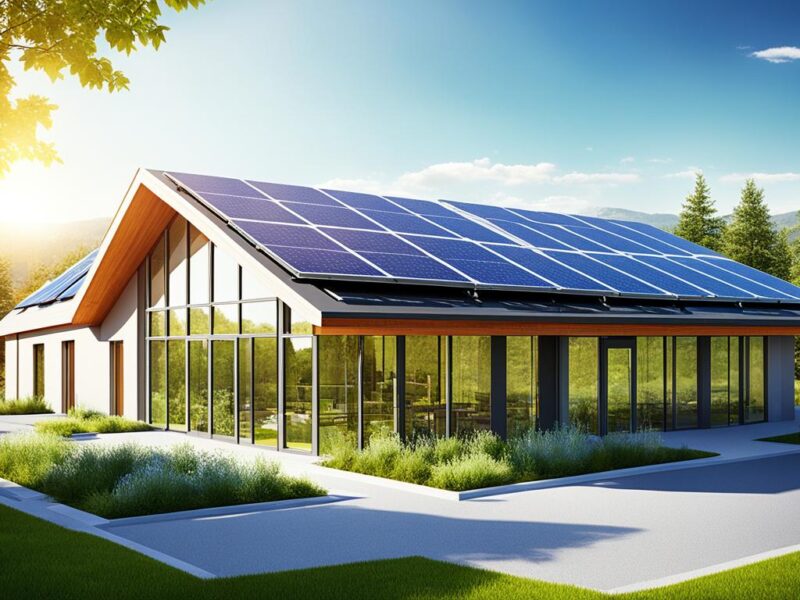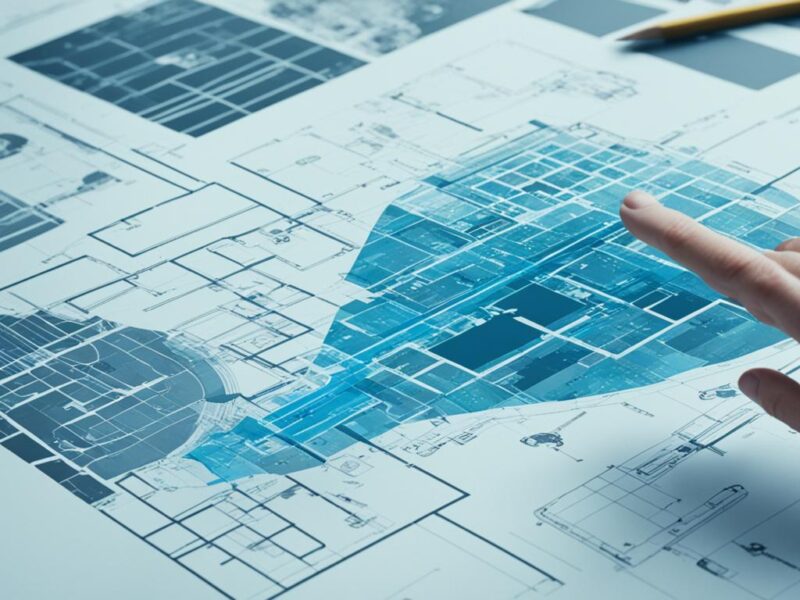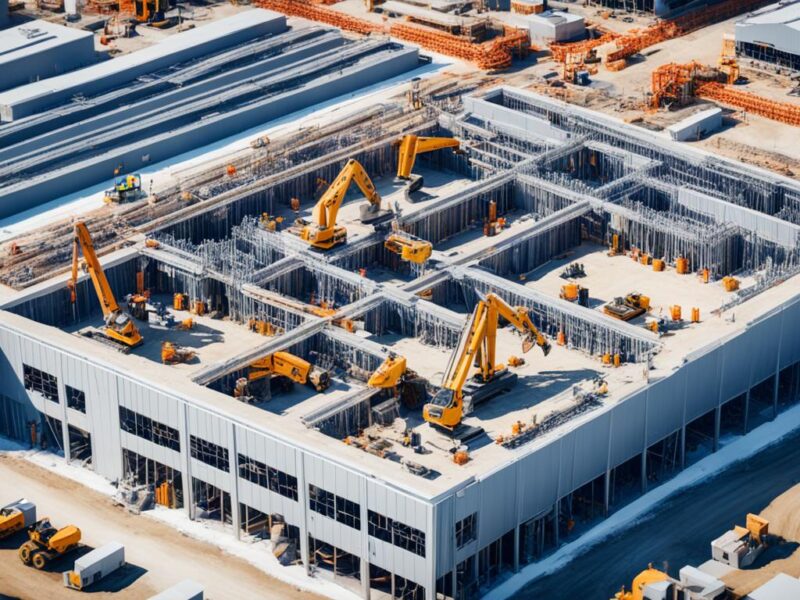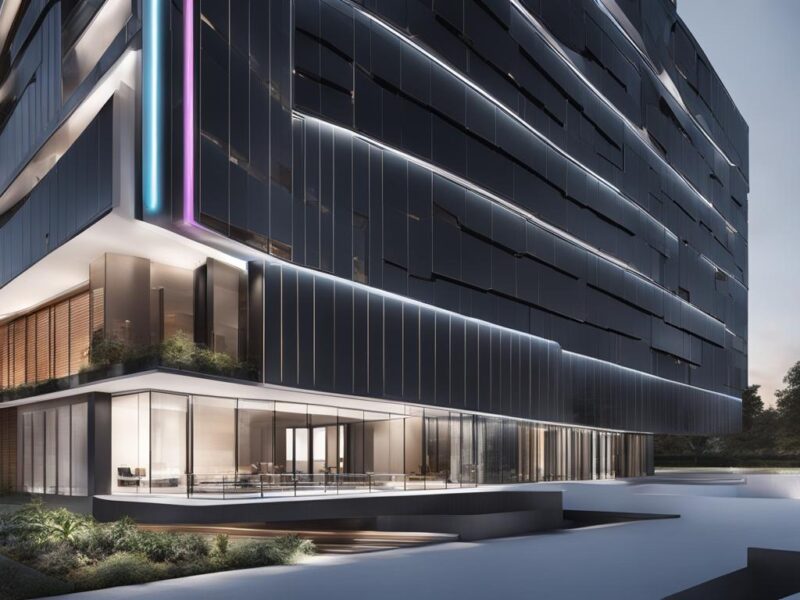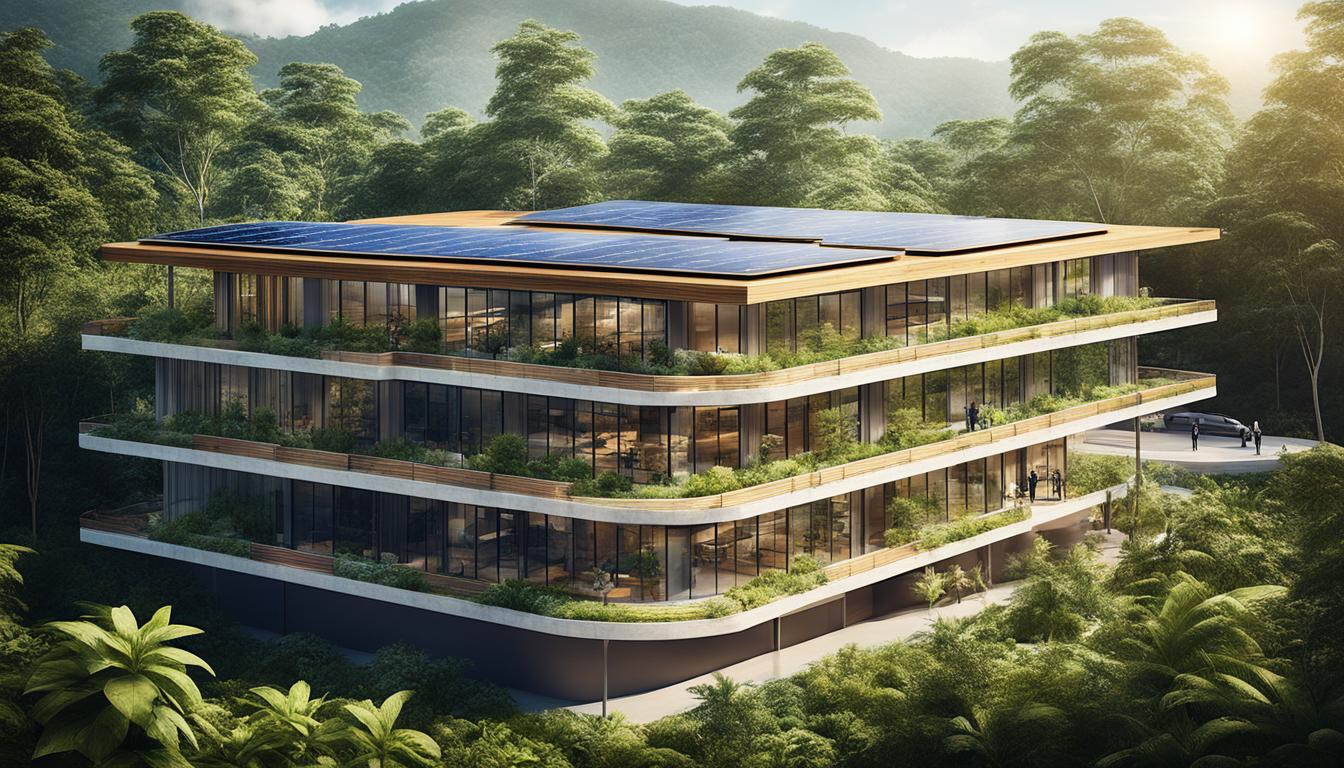
Eco-Friendly Architecture: Sustainable Designs
Did you know that buildings are responsible for 39% of carbon dioxide (CO2) emissions worldwide? As the need for environmental sustainability becomes increasingly urgent, the focus on eco-friendly architecture and sustainable building design has never been more crucial.
Benefits of Sustainable Architecture
There are several notable benefits associated with sustainable architecture. By embracing eco-conscious building practices and utilizing eco-friendly building materials, architects and builders can contribute to the creation of energy-efficient structures and foster sustainable urban planning. Such practices help to reduce carbon emissions, minimize the negative effects of construction on the environment, and create a more sustainable future.
“Sustainable buildings are designed to be energy-efficient, incorporating features such as solar power and efficient insulation.”
Sustainable architecture focuses on designing energy-efficient structures that optimize resource utilization and reduce waste. Energy-efficient buildings incorporate various features such as solar power systems, energy-saving insulation, and natural lighting to reduce energy consumption. These practices help to minimize carbon emissions, conserve valuable resources, and create healthier and more sustainable living and working environments.
Moreover, sustainable architecture promotes eco-conscious building practices by encouraging the use of sustainable and recycled materials. By utilizing eco-friendly building materials, which have a lower carbon footprint and are healthier for occupants, sustainable buildings contribute to a greener future.
Sustainable architecture also plays a vital role in the context of sustainable urban planning. By designing buildings and communities with walkability in mind, architects and urban planners can minimize the need for cars and promote environmentally friendly mobility options. Sustainable urban planning creates cities and neighborhoods that are vibrant, accessible, and safer for pedestrians and cyclists.
“Sustainable architecture helps to create walkable cities and reduce the need for cars.”
By adopting sustainable architecture principles, communities can enjoy numerous benefits such as reduced traffic congestion, improved air quality, enhanced public health, and increased social interaction.
The following table provides a summary of the benefits of sustainable architecture:
| Benefits | Description |
|---|---|
| Reduced carbon emissions | Sustainable buildings minimize the negative impact on the environment by reducing carbon emissions associated with energy consumption. |
| Energy efficiency | Energy-efficient design and features result in reduced energy consumption and cost savings. |
| Eco-conscious building practices | Emphasizes the use of sustainable and recycled materials, contributing to a greener future. |
| Sustainable urban planning | Creates walkable cities, reducing the need for cars and promoting a more sustainable and livable environment. |
| Eco-friendly building materials | Utilization of materials with a lower carbon footprint, promoting a healthier environment for both occupants and the surrounding ecosystem. |
Sustainable architecture offers a way forward for the construction industry, aligning design and construction practices with the goal of environmental sustainability. By prioritizing energy efficiency, eco-conscious practices, sustainable urban planning, and the adoption of eco-friendly building materials, architects and builders can contribute to a greener and more sustainable future.
Innovations in Sustainable Architecture
Sustainable architecture is continuously evolving, with innovative ideas and practices emerging to create environmentally conscious buildings. These innovations aim to minimize the negative impact of construction on the environment while promoting sustainable living. From the use of living walls to the concept of the 15-minute city, let’s explore some of the exciting developments in sustainable architecture.
Living Walls: Bringing Nature Indoors

Living walls, also known as vertical gardens or green walls, are an innovative concept in sustainable architecture. These vertical structures are covered in plants that not only enhance the aesthetic appeal of a building but also provide numerous benefits. Living walls help to improve air quality by removing pollutants and increasing oxygen levels. They also act as natural insulation, regulating temperature and reducing energy consumption. Additionally, these green installations can reduce noise levels and create a sense of tranquility in urban environments.
The 15-minute City: Promoting Sustainable Urban Living
The 15-minute city model is gaining popularity as a sustainable urban planning concept. The idea behind the 15-minute city is to design urban spaces where residents can access their daily needs within a 15-minute distance, whether by walking, cycling, or using public transportation. By creating mixed-use neighborhoods that integrate residential, commercial, and recreational areas, the 15-minute city aims to reduce reliance on cars and promote a more sustainable way of living. This approach not only reduces carbon emissions but also enhances the quality of life by making essential amenities easily accessible to all.
Green Technologies and Renewable Energy Sources
Green technologies and renewable energy sources play a vital role in sustainable architecture. By harnessing the power of renewable energy, such as solar power, buildings can reduce their reliance on non-renewable resources and minimize their environmental impact. Solar panels can be integrated into the design of a building, providing clean and sustainable energy. Other green technologies, such as energy-efficient lighting systems and smart building management systems, help optimize energy usage and contribute to overall sustainability.
Evolving Sustainable Materials
Sustainable architecture also emphasizes the use of eco-friendly and recycled materials. The construction industry is continually exploring new materials that have a lower carbon footprint and are more environmentally friendly. From sustainable wood products to recycled steel, these materials contribute to reducing waste and promoting a circular economy. By incorporating these materials into the design and construction process, architects can create buildings that are not only visually appealing but also environmentally sustainable.
| Benefits of Innovations | Description |
|---|---|
| Improved Air Quality | Living walls act as natural air filters, removing pollutants and increasing oxygen levels. |
| Energy Efficiency | Living walls provide natural insulation, reducing the need for artificial cooling or heating. |
| Accessible Amenities | The 15-minute city model ensures that essential amenities are within a short distance, reducing the need for car travel. |
| Renewable Energy Integration | Green technologies and renewable energy sources reduce reliance on non-renewable resources and contribute to a greener future. |
| Sustainable Material Usage | Eco-friendly and recycled materials promote a circular economy and minimize environmental impact. |
Sustainable Materials and Design Techniques
In sustainable architecture, the choice of materials and design techniques plays a crucial role in reducing the environmental impact of construction. By utilizing natural siding materials, low-maintenance exterior siding, recycled materials, and passive heating and cooling strategies, architects can create buildings that are both eco-friendly and energy-efficient.
Natural Siding Materials
One of the key aspects of sustainable architecture is the use of natural siding materials. These materials are sourced from sustainable forests and manufactured using environmentally friendly processes. One popular choice is sustainably sourced wood, which not only adds warmth and aesthetic appeal to buildings but also helps to minimize the carbon footprint of construction.
Low-Maintenance Exterior Siding
Choosing low-maintenance exterior siding solutions is another important consideration in sustainable design. These materials require minimal upkeep and contribute to the longevity of buildings, reducing waste and energy costs over time. By opting for low-maintenance siding options, such as fiber cement or composite materials, architects can create durable and environmentally conscious structures.
Recycled Materials
Integrating recycled materials into construction projects is a fundamental principle of sustainable architecture. By using recycled materials like reclaimed wood, recycled glass, or recycled metal, architects can reduce reliance on virgin resources and promote a circular economy. Incorporating these materials not only helps to minimize waste but also adds unique character and visual interest to the building.
Passive Heating and Cooling
Passive heating and cooling techniques are essential in sustainable design to maximize energy efficiency and minimize reliance on active heating and cooling systems. Strategies such as open rainscreens, strategic window placement, and natural ventilation help regulate indoor temperatures and reduce the need for artificial cooling or heating. This approach not only saves energy but also enhances the comfort and well-being of building occupants.
These sustainable materials and design techniques are critical in creating buildings that are both environmentally friendly and energy-efficient. By prioritizing the use of natural siding materials, low-maintenance exterior siding, recycled materials, and passive heating and cooling strategies, sustainable architects can contribute to a greener future while providing aesthetically pleasing and functional spaces.
Conclusion
Sustainable design in architecture is instrumental in mitigating the adverse impact of buildings on the environment. By incorporating eco-friendly practices, utilizing sustainable materials, and implementing energy-efficient solutions, architects and builders have the power to create structures that promote environmental sustainability. From harnessing renewable energy sources to designing walkable cities, sustainable architecture aims to pave the way for a greener future.
It is imperative for the construction industry to prioritize sustainability and consider the long-term effects of their projects to safeguard the planet for future generations. With continued advancements and innovations, eco-friendly architecture can become the norm and contribute to a more sustainable and harmonious built environment.
Sustainable design is not only about minimizing carbon emissions and reducing the negative impact of construction; it is also an opportunity to create aesthetically pleasing and functional spaces that align with environmental consciousness. By embracing sustainable design principles, we can create buildings that not only stand the test of time but also support the overall well-being of individuals and communities.
Environmental sustainability should be at the forefront of every architectural endeavor. By incorporating sustainable design practices and green construction techniques, we can achieve a built environment that not only minimizes harm but also contributes positively to our planet’s health. Let us embrace eco-friendly architecture as a guiding principle for a more sustainable future.
FAQ
What is eco-friendly architecture?
Eco-friendly architecture refers to the practice of designing and constructing buildings that minimize their negative impact on the environment. It focuses on using sustainable building materials, incorporating renewable energy sources, and implementing green construction techniques.
What are the benefits of sustainable architecture?
Sustainable architecture helps to reduce carbon emissions, minimize the negative effects of construction on the environment, and promote eco-conscious building practices. It contributes to sustainable urban planning, reduces the need for cars, and utilizes eco-friendly building materials that are healthier for occupants and the environment.
What are some innovations in sustainable architecture?
Innovations in sustainable architecture include the concept of living walls, which improve air quality and energy efficiency. The 15-minute city model is gaining popularity, designing urban spaces where residents can access their daily needs within a 15-minute distance. Sustainable architecture also incorporates the use of green technologies and renewable energy sources, such as solar power.
What are some sustainable materials and design techniques used in architecture?
Sustainable architecture emphasizes the use of natural siding materials, low-maintenance exterior siding solutions, and recycled materials to minimize the carbon footprint of construction. Passive heating and cooling techniques, such as open rainscreens and strategic window placement, maximize energy efficiency and reduce the need for active heating and cooling systems.
How does sustainable architecture promote environmental sustainability?
By incorporating eco-friendly practices, utilizing sustainable materials, and implementing energy-efficient solutions, sustainable architecture helps minimize the negative impact of buildings on the environment. It aims to create a greener future by using renewable energy sources, designing walkable cities, and prioritizing long-term sustainability in construction projects.




